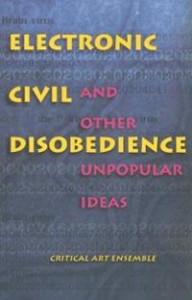Critical Art Emsemble, ECD
Lo más importante, el libro ELECTRONIC CIVIL DESOBEDIENCE, ECD.
This book continues the exploration begun in The Electronic Disturbance (TED). While TED was very well received, critics continually mentioned two primary shortcomings. The first was that while TED explains the nature of nomadic power in the age of the virtual, very little is said about nomadic resistance on the net or in the bunker. In this work, CAE offers a preliminary outline concerning rational strategy (antilogos) and tactical possibilities for nomadic resistance. In other words, the matters described in the following pages are the oppositional counterparts of nomadic power (i.e., domination) at this historical moment.
In the final four chapters, CAE replies to the second most common criticism. Some have mentioned that while CAE often recommends strategies of the nonrational, in TED, none is actually offered. In the pages that follow, CAE tries to get beyond the traditional activist position enveloped in anti-logos (rationalized resistance to domination) by searching for the (non)location of the inherently contestational energy of nomos. As in TED, in this work CAE continues to maintain that the social dynamic of nomos, which typically appears as explosive and unstoppable moments of excess, waste, sacrifice, abjectivity, spontaneity, mania, and uselessness, must function as a parallel engine of resistance alongside the anti-logos. These elements of existence are truly at the heart of individual autonomy, and yet they are seldom acknowledged by activist culture. Like rational society itself, activist culture tries to organize them out of existence, or at least to the point where they no longer appear. Here, CAE examines how these elements have entwined themselves with rational visible culture. While we may not extract tactical possibilities for political and cultural resistance from these observations, we do hope to contribute to the production of the ideational conditions for such possibilities to emerge in the realms of appearance and action.
The most important, the book ELECTRONIC CIVIL DESOBEDIENCE, ECD.
This book continues the exploration begun in The Electronic Disturbance (TED). While TED was very well received, critics continually mentioned two primary shortcomings. The first was that while TED explains the nature of nomadic power in the age of the virtual, very little is said about nomadic resistance on the net or in the bunker. In this work, CAE offers a preliminary outline concerning rational strategy (antilogos) and tactical possibilities for nomadic resistance. In other words, the matters described in the following pages are the oppositional counterparts of nomadic power (i.e., domination) at this historical moment.
In the final four chapters, CAE replies to the second most common criticism. Some have mentioned that while CAE often recommends strategies of the nonrational, in TED, none is actually offered. In the pages that follow, CAE tries to get beyond the traditional activist position enveloped in anti-logos (rationalized resistance to domination) by searching for the (non)location of the inherently contestational energy of nomos. As in TED, in this work CAE continues to maintain that the social dynamic of nomos, which typically appears as explosive and unstoppable moments of excess, waste, sacrifice, abjectivity, spontaneity, mania, and uselessness, must function as a parallel engine of resistance alongside the anti-logos. These elements of existence are truly at the heart of individual autonomy, and yet they are seldom acknowledged by activist culture. Like rational society itself, activist culture tries to organize them out of existence, or at least to the point where they no longer appear. Here, CAE examines how these elements have entwined themselves with rational visible culture. While we may not extract tactical possibilities for political and cultural resistance from these observations, we do hope to contribute to the production of the ideational conditions for such possibilities to emerge in the realms of appearance and action.